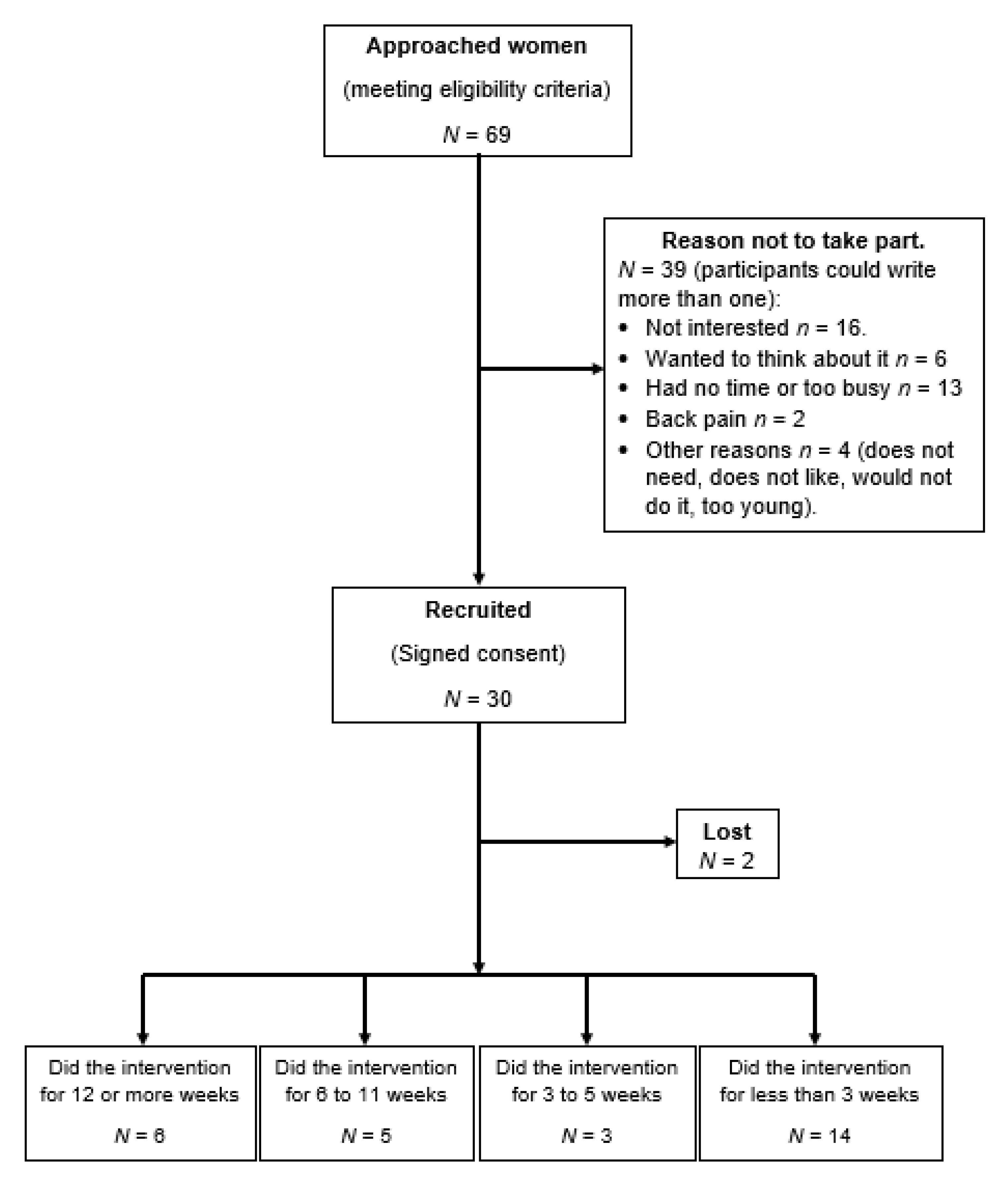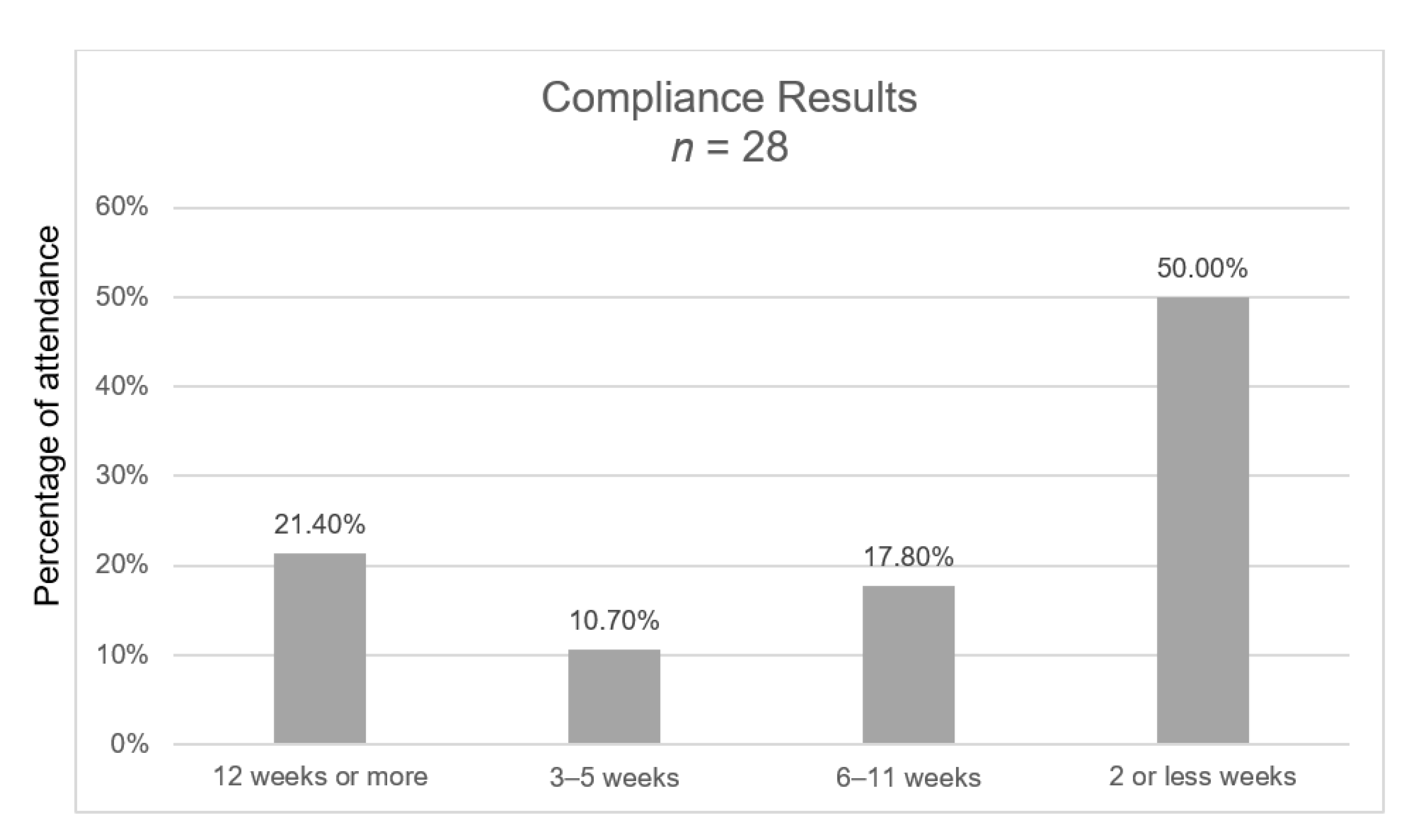Options in Pregnancy to Increase ActiveLy Sitting (OPALS) Feasibility Study
Abstract
1. Introduction
2. Materials and Methods
2.1. Design
2.2. Ethics Approval
2.3. Setting
2.4. Characteristics of Participants
2.5. Description of Intervention
2.6. Exercise Intervention
2.7. Materials
2.8. Analysis
2.9. Sample Size
3. Results
4. Discussion
4.1. Study Strengths
4.2. Study Limitations
4.3. Practice Implications
5. Conclusions
Author Contributions
Funding
Institutional Review Board Statement
Informed Consent Statement
Acknowledgments
Conflicts of Interest
References
- Heslehurst, N.; Simpson, H.; Ells, L.J.; Rankin, J.; Wilkinson, J.; Lang, R.; Brown, T.J.; Summerbell, C.D. The impact of maternal BMI status on pregnancy outcomes with immediate short-term obstetric resource implications: A meta-analysis. Obes. Rev. 2008, 9, 635–683. [Google Scholar] [CrossRef]
- Denison, F.; Norwood, P.; Bhattacharya, S.; Duffy, A.; Mahmood, T.; Morris, C.; Raja, E.; Norman, J.; Lee, A.; Scotland, G. Association between maternal body mass index during pregnancy, short-term morbidity, and increased health service costs: A population-based study. BJOG Int. J. Obstet. Gynaecol. 2014, 121, 72–82. [Google Scholar] [CrossRef] [PubMed]
- Huda, S.S.; Brodie, L.E.; Sattar, N. Obesity in pregnancy: Prevalence and metabolic consequences. Semin. Fetal Neonatal Med. 2010, 15, 70–76. [Google Scholar] [CrossRef]
- Fitzsimons, K.J.; Modder, J. Setting maternity care standards for women with obesity in pregnancy. Semin. Fetal Neonatal Med. 2010, 15, 100–107. [Google Scholar] [CrossRef] [PubMed]
- Norman, J.E.; Reynolds, R. The consequences of obesity and excess weight gain in pregnancy. Proc. Nutr. Soc. 2011, 70, 450–456. [Google Scholar] [CrossRef] [PubMed]
- Reynolds, R.M.; Allan, K.M.; Raja, E.A.; Bhattacharya, S.; McNeill, G.; Hannaford, P.C.; Sarwar, N.; Lee, A.J.; Bhattacharya, S.; Norman, J.E. Maternal obesity during pregnancy and premature mortality from cardiovascular event in adult offspring: Follow-up of 1,323,275 person years. BMJ 2013, 347, f4539. [Google Scholar] [CrossRef] [PubMed]
- Scott-Pillai, R.; Spence, D.; Cardwell, C.R.; Hunter, A.; Holmes, V.A. The impact of body mass index on maternal and neonatal outcomes: A retrospective study in a UK obstetric population, 2004–2011. BJOG Int. J. Obstet. Gynaecol. 2013, 120, 932–939. [Google Scholar] [CrossRef] [PubMed]
- Lisonkova, S.; Muraca, G.M.; Potts, J.; Liauw, J.; Chan, W.-S.; Skoll, A.; Lim, K.I. Association Between Prepregnancy Body Mass Index and Severe Maternal Morbidity. Obstet. Gynecol. Surv. 2018, 73, 197–198. [Google Scholar] [CrossRef]
- Schummers, L.; Hutcheon, J.A.; Bodnar, L.M.; Lieberman, E.; Himes, K.P. Risk of Adverse Pregnancy Outcomes by Prepregnancy Body Mass Index: A Population-Based Study to Inform Prepregnancy Weight Loss Counseling. Obstet. Gynecol. 2015, 125, 133–143. [Google Scholar] [CrossRef]
- Blomberg, M. Maternal Obesity, Mode of Delivery, and Neonatal Outcome. Obstet. Anesth. Digest. 2014, 34, 148–149. [Google Scholar] [CrossRef]
- World Health Organization. WHO Guidelines on Physical Activity and Sedentary Behaviour; World Health Organization: Geneva, Switzerland, 2020; Available online: https://www.who.int/publications/i/item/9789240015128 (accessed on 22 August 2018).
- Kennelly, M.A.; Ainscough, K.; Lindsay, K.L.; O’Sullivan, E.; Gibney, E.R.; McCarthy, M.; Segurado, R.; DeVito, G.; Maguire, O.; Smith, T.; et al. Pregnancy Exercise and Nutrition with Smartphone Application Support: A Randomized Controlled Trial. Obstet. Gynecol. 2018, 131, 818–826. [Google Scholar] [CrossRef] [PubMed]
- Poston, L.; Bell, R.; Croker, H.; Flynn, A.C.; Godfrey, K.M.; Goff, L.; Hayes, L.; Khazaezadeh, N.; Nelson, S.M.; Oteng-Ntim, E.; et al. Effect of a behavioural intervention in obese pregnant women (the UPBEAT study): A multicentre, randomised controlled trial. Lancet Diabetes Endocrinol. 2015, 3, 767–777. [Google Scholar] [CrossRef]
- Nascimento, S.; Surita, F.; Parpinelli, M.; Siani, S.; Pinto e Silva, J.L. The effect of an antenatal physical exercise programme on maternal/perinatal outcomes and quality of life in overweight and obese pregnant women: A randomised clinical trial. BJOG Int. J. Obstet. Gynaecol. 2011, 118, 1455–1463. [Google Scholar] [CrossRef]
- Ong, M.J.; Guelfi, K.J.; Hunter, T.; Wallman, K.E.; Fournier, P.A.; Newnham, J.P. Supervised home-based exercise may attenuate the decline of glucose tolerance in obese pregnant women. Diabetes Metab. 2009, 35, 418–421. [Google Scholar] [CrossRef] [PubMed]
- Di Fabio, D.R.; Blomme, C.K.; Smith, K.M.; Welk, G.J.; Campbell, C.G. Adherence to physical activity guidelines in mid-pregnancy does not reduce sedentary time: An observational study. Int. J. Behav. Nutr. Phys. Act. 2015, 12, 8. [Google Scholar] [CrossRef] [PubMed]
- da Silva, S.G.; Ricardo, L.I.; Evenson, K.R.; Hallal, P.C. Leisure-Time Physical Activity in Pregnancy and Maternal-Child Health: A Systematic Review and Meta-Analysis of Randomized Controlled Trials and Cohort Studies. Sports Med. 2016, 47, 295–317. [Google Scholar] [CrossRef] [PubMed]
- Smith, S.M.; Bayliss, E.A.; Mercer, S.W.; Gunn, J.; Vestergaard, M.; Wyke, S.; Salisbury, C.; Fortin, M. How to design and evaluate interventions to improve outcomes for patients with multimorbidity. J. Comorbidity 2013, 3, 10–17. [Google Scholar] [CrossRef]
- Rajadhyaksha, V. Conducting Feasibilities in Clinical Trials: An Investment to Ensure a Good Study. Perspect. Clin. Res. 2010, 1, 106–109. [Google Scholar]
- Borg, G. Borg’s Perceived Exertion and Pain Scales; Human Kinetics: Champaign, IL, USA, 1998; 104p. [Google Scholar]
- Bulger, S. Basic Training Principles. In Physical Education for Lifelong Fitness the Physical Best Teacher Guide, 3rd ed.; Human Kinetics: Champaign, IL, USA, 2010. [Google Scholar]
- Kenney, W.L.; Wilmore, J.H.; Costill, D.L. Physiology of Sport and Exercise, 6th ed.; Human Kinetics: Champaign, IL, USA, 2015. [Google Scholar]
- Mottola, M.F. Physical activity and maternal obesity: Cardiovascular adaptations, exercise recommendations, and pregnancy outcomes. Nutr. Rev. 2013, 71, S31–S36. [Google Scholar] [CrossRef]
- Dipietro, L.; Evenson, K.R.; Bloodgood, B.; Sprow, K.; Troiano, R.P.; Piercy, K.L.; Vaux-Bjerke, A.; Powell, K.E. Benefits of Physical Activity during Pregnancy and Postpartum: An Umbrella Review. Med. Sci. Sports Exerc. 2019, 51, 1292–1302. [Google Scholar] [CrossRef]
- Chakrabarti, S. What’s in a name? Compliance, adherence and concordance in chronic psychiatric disorders. World J. Psychiatry 2014, 4, 30–36. [Google Scholar] [CrossRef] [PubMed]
- Whitehead, A.L.; Julious, S.A.; Cooper, C.L.; Campbell, M.J. Estimating the sample size for a pilot randomised trial to minimise the overall trial sample size for the external pilot and main trial for a continuous outcome variable. Stat. Methods Med. Res. 2016, 25, 1057–1073. [Google Scholar] [CrossRef]
- Seneviratne, S.N.; Jiang, Y.; Derraik, J.G.B.; McCowan, L.M.E.; Parry, G.K.; Biggs, J.B.; Craigie, S.; Gusso, S.; Peres, G.; Rodrigues, R.O.; et al. Effects of antenatal exercise in overweight and obese pregnant women on maternal and perinatal outcomes: A randomised controlled trial. BJOG Int. J. Obstet. Gynaecol. 2016, 123, 588–597. [Google Scholar] [CrossRef] [PubMed]
- Weir, Z.; Bush, J.; Robson, S.C.; McParlin, C.; Rankin, J.; Bell, R. Physical activity in pregnancy: A qualitative study of the beliefs of overweight and obese pregnant women. BMC Pregnancy Childbirth 2010, 10, 18. [Google Scholar] [CrossRef] [PubMed]


| Regarding the Intervention | Participated for 6 or More Weeks (n = 11) | Participated for 12 or More Weeks (n = 6) |
|---|---|---|
| Time performing on average | 11 weeks | 13 weeks |
| First child | 5 (45.4%) | 4 (66.7%) |
| Had children | 6 (54.6%) | 2 (33.3%) |
| Frequency per week on average | 4 times per week | 4 times per week |
| Once per day | 8 (72.7%) | 4 (66.7%) |
| More than once per day | 3 (27.3%) | 2 (33.3%) |
| Enjoyable Yes | 10 (90.9%) | 5 (83.3%) |
| Will keep on doing | 9 (81.8%) | 6 (100%) |
| Easy to participate and follow the instructions | 11 (100%) | 6 (100%) |
| Performance improved Yes | 9 (81.8%) | 5 (83.3%) |
| Made feel better | 10 (90.9%) | 6 (100%) |
| The diary was helpful Yes | 10 (90.9%) | 6 (100%) |
| Reasons | Frequency | Percentage |
|---|---|---|
| Finding the time to do the exercises | 3 | 21.4% |
| Pelvic pain | 3 | 21.4% |
| Too busy | 2 | 14.3% |
| Sickness | 2 | 14.3% |
| Different reasons each (tediousness, extreme anxiety, etc.) | 3 | 7.2% |
| No answer | 1 | 7.2% |
Publisher’s Note: MDPI stays neutral with regard to jurisdictional claims in published maps and institutional affiliations. |
© 2021 by the authors. Licensee MDPI, Basel, Switzerland. This article is an open access article distributed under the terms and conditions of the Creative Commons Attribution (CC BY) license (https://creativecommons.org/licenses/by/4.0/).
Share and Cite
Fazzi, C.; Denison, F.C.; Saunders, D.H.; Norman, J.E.; Reynolds, R.M. Options in Pregnancy to Increase ActiveLy Sitting (OPALS) Feasibility Study. Int. J. Environ. Res. Public Health 2021, 18, 5673. https://doi.org/10.3390/ijerph18115673
Fazzi C, Denison FC, Saunders DH, Norman JE, Reynolds RM. Options in Pregnancy to Increase ActiveLy Sitting (OPALS) Feasibility Study. International Journal of Environmental Research and Public Health. 2021; 18(11):5673. https://doi.org/10.3390/ijerph18115673
Chicago/Turabian StyleFazzi, Caterina, Fiona C. Denison, David H. Saunders, Jane E. Norman, and Rebecca M. Reynolds. 2021. "Options in Pregnancy to Increase ActiveLy Sitting (OPALS) Feasibility Study" International Journal of Environmental Research and Public Health 18, no. 11: 5673. https://doi.org/10.3390/ijerph18115673
APA StyleFazzi, C., Denison, F. C., Saunders, D. H., Norman, J. E., & Reynolds, R. M. (2021). Options in Pregnancy to Increase ActiveLy Sitting (OPALS) Feasibility Study. International Journal of Environmental Research and Public Health, 18(11), 5673. https://doi.org/10.3390/ijerph18115673






